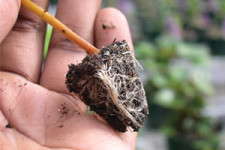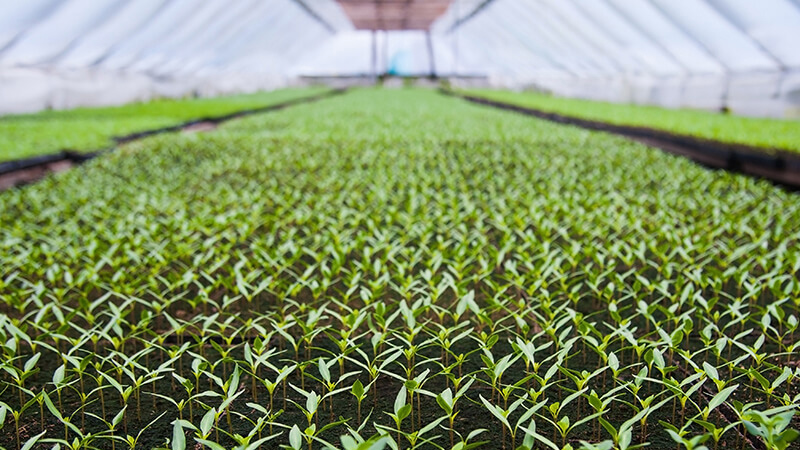Preventing Plug Stunting

We have all heard the cliché doctors make the worst patients. Well, sometimes greenhouse growers make the worst horticulturists.
We have learned over the years just how far we can push our plants. A case in point is plugs. They often arrive in large batches, usually when there are not enough folks to transplant them or, more likely, when there is not enough space to put finished plants.
Of course, when the season is busy, more plug shipments arrive before we have a chance to finish potting the previous ones. The result: Plugs sit on the bench for days or weeks, continuing to grow. They can become quite leggy, sometimes nutrient deficient or, in worse cases, die. But we still need the finished plants. So we pot them eventually and often, they never produce a quality plant.
So can anything be done to produce high-quality plants from these plugs? We set out to answer that question and a couple more–which species are sensitive to stunting in the flat, and can we prevent the stunting from occurring?
Understand Species Responses
We started by determining several species that are sensitive to stunting in the plug flat by growing a number of species in the fall and in the spring. In the fall, seed of ‘Telstar Picotee’ dianthus, ‘Daybreak Mix’ gazania, ‘Red Peacock’ ornamental kale, ‘Floral Showers Coral Bicolor’ snapdragon, ‘Harmony Cherry Blossom’ and ‘Christmas Ruby’ stock, and ‘Starlet Rose with Blotch’ viola were sown in 288-size plug flats in a peat-based commercial substrate (Fafard 4P). Seed of ‘Pink Fantasy’ larkspur was sown in a 200-size plug flat.
Plugs were first transplanted when the roots were sufficiently developed so plugs could be easily removed from flats. This is known as pullable plug stage (PPS). Additional plugs were removed and transplanted from the same flats every two weeks thereafter for eight weeks.
In the spring, seed of ‘Harmony Pink’ begonia, ‘Matsumoto Rose’ annual aster, ‘Century Red’ celosia, ‘Dazzler Red’ impatiens, ‘Pink Fantasy’ larkspur, ‘Balboa Purple’ lisianthus, ‘Little Devil Fire’ marigold and ‘Heartland’ tomato were sown in 288-size plug flats and handled as in the fall.
We considered a plant plug stunted if it died after transplanting or did not resume a normal growth rate. The species most sensitive to being grown in plugs died. For example, in the spring annual aster and larkspur, plugs held for eight weeks past PPS, died in the plug flat. And those transplanted six weeks past PPS died before the experiment was completed. Other species, such as celosia, dianthus and marigold, lived even when transplanting was delayed eight weeks, but the finished plants were smaller than those transplanted at PPS.
Finished plants of the remaining taxa–gazania, impatiens, lisianthus, ornamental kale, snapdragon, stock, tomato and viola–were not affected by the amount of time held in the plug flat after PPS. These taxa allow the industry more flexibility in terms of transplanting time. Needless to say, the plugs grew much taller the longer they were held in the flats. For those species, such as begonia, all of the plants had the same growth rate after transplanting, and because the plugs held eight weeks past PPS were taller, they finished taller.
For some species, such as stock, the difference in height between the plants transplanted at PPS and those transplanted up to eight weeks past PPS disappeared by the time the finished plants were ready to market.
While plugs of the flat-tolerant species were not stunted by being held in the flats, plug quality was reduced. The plants were tall with fewer side shoots. After transplanting, they took longer to produce an acceptable quality finished plant.
Preventing Plug Stunting
When plugs arrive, first check them to see what stage they are in. Sometimes, plugs are not quite at PPS and should be grown for a while longer to be easily pulled from flats. For flats already at PPS, sort into those species that should be transplanted immediately and those that can tolerate delayed transplanting. Focus on those species that should be transplanted immediately.
If they cannot all be transplanted, make an estimate of those that can be transplanted within a week and pull those. The rest should be placed in a cool growing house or in a cooler, which will slow development greatly and help retain quality.
The optimum temperature varies with the species, from 36 to 50°F. The ideal temperature for alyssum, begonia, geranium, pansy, and petunia is 36°F. The ideal temperature for ageratum, dahlia, lobelia, marigold and portulaca is 41°F. The ideal temperature for salvia, tomato, verbena, and vinca is 45°F. The ideal temperature for celosia is 50°F, and 55°F for impatiens.
Warmer temperatures can be used, but if so, plugs should not be stored as long. The use of low light levels in the cooler will also improve quality for most species. Be sure the plug medium is moist but the foliage is dry before placing in the cooler. Good air circulation and fungicide applications may be helpful to prevent botrytis. Do not set all the flats out and decide weeks later to cool some of the plugs. By then, damage may have occurred that you won’t see until the crop finishes.
Of course, species that tolerated long durations in the plug flats will be much easier to handle. Be aware, however, that while the plants may not stunt, plug quality can be reduced as the plants will grow tall, spindly and have few side shoots. This can be reduced by the application of growth retardants. Also, reduce water and fertilizer but do not allow plugs to be drought or nutrient stressed, as that may enhance stunting later. This will require an experienced and attentive grower.
If you chronically have plugs flats that you can’t transplant on time, you may want to take an honest look at your production program. Do you really have enough space and/or labor to handle all of the plants on the production plan? If not, make your production plan realistic.
If you are growing your own plugs, it might be helpful to schedule more sowings so you won’t have as many plug flats ready to be transplanted at once. Certainly, this adds to labor, but it will improve plant quality.
Finally, one small step is to grow or order plugs in flats with deeper cells. Plugs in larger cells (i.e. 200 versus 288) can also be grown longer before being stunted, but that will influence the cost to grow and order the plugs and the amount of space needed to hold and grow the flats.
Preventing Damage
Unfortunately, we have found little that can be done after the plugs are stunted. Gibberellic acid was tried and may improve growth rate but plant quality was low. Your best course of action is to slow growth as discussed above.








